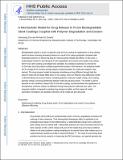A mechanistic model for drug release in PLGA biodegradable stent coatings coupled with polymer degradation and erosion
Author(s)
Zhu, Xiaoxiang; Braatz, Richard D
DownloadBraatz_A mechanistic model.pdf (706.9Kb)
OPEN_ACCESS_POLICY
Open Access Policy
Creative Commons Attribution-Noncommercial-Share Alike
Terms of use
Metadata
Show full item recordAbstract
Biodegradable poly(d,l-lactic-co-glycolic acid) (PLGA) coating for applications in drug-eluting stents has been receiving increasing interest as a result of its unique properties compared with biodurable polymers in delivering drug for reducing stents-related side effects. In this work, a mathematical model for describing the PLGA degradation and erosion and coupled drug release from PLGA stent coating is developed and validated. An analytical expression is derived for PLGA mass loss that predicts multiple experimental studies in the literature. An analytical model for the change of the number-average degree of polymerization [or molecular weight (MW)] is also derived. The drug transport model incorporates simultaneous drug diffusion through both the polymer solid and the liquid-filled pores in the coating, where an effective drug diffusivity model is derived taking into account factors including polymer MW change, stent coating porosity change, and drug partitioning between solid and aqueous phases. The model is used to describe in vitro sirolimus release from PLGA stent coating, and demonstrates the significance of simultaneous sirolimus release via diffusion through both polymer solid and pore space. The proposed model is compared to existing drug transport models, and the impact of model parameters, limitations and possible extensions of the model are also discussed.
Date issued
2015-05Department
Massachusetts Institute of Technology. Department of Chemical EngineeringJournal
Journal of Biomedical Materials Research Part A
Publisher
John Wiley & Sons, Inc.
Citation
Zhu, Xiaoxiang, and Richard D. Braatz. “A Mechanistic Model for Drug Release in PLGA Biodegradable Stent Coatings Coupled with Polymer Degradation and Erosion.” Journal of Biomedical Materials Research Part A 103, no. 7 (November 12, 2014): 2269–2279.
Version: Author's final manuscript
ISSN
15493296